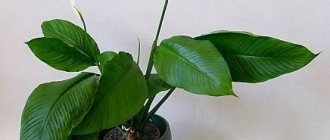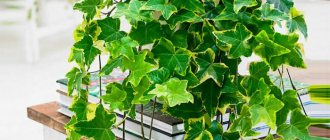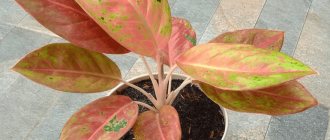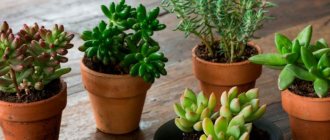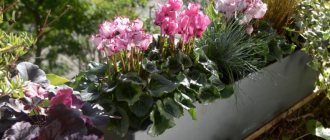Spathiphyllum was first discovered and described by the German botanist and enthusiast Gustav Wallis back in the 19th century.
The plants that attracted the attention of the scientist are still common in Colombia and other countries in the region. Many spathiphyllums can be seen along the swampy shores of reservoirs, in the undergrowth of tropical rainforests. The plant, which came to the USA and Europe, attracted the attention of flower growers. As an indoor plant, spathiphyllum has become well known throughout the world. But breeding work to develop new varieties and hybrids began relatively recently, only in the mid-60s of the last century.
The appearance of plants suitable for growing indoors:
- dwarf and impressive sizes;
- with leaves of various shapes and colors;
- having a pleasant smell;
- capable of blooming for a long time and almost constantly, caused a serious increase in interest in the culture.
Today, amateur flower growers have dozens of varieties of spathiphyllum at their disposal, photos of which allow them to constantly be amazed at the diversity of nature.
Features and photo of spathiphyllum flower
Spathiphyllum, like many plants living in tropical and subtropical zones, does not shed its leaves all year round, remaining green and attractive. The leaves of the plant are quite large, elongated-lanceolate, with depressed veins and a glossy surface.
Since spathiphyllum has practically no stem, or it is very shortened and spreads along the ground, the leaves rise directly from the ground. And during the flowering period, graceful peduncles with white bracts surrounding a white or yellowish cob rise above the plants. Contrary to popular belief, the photo shows not a spathiphyllum flower, but its inflorescence. But small flowers collected in a cob have neither petals nor external attractiveness.
Therefore, during the course of evolution, the plant acquired a white and then green bract. It is like a flag, attracting the attention of insects. Today, botanists know more than four dozen species of spathiphyllum. Only a few varieties are used as indoor crops and for landscaping. The most common inhabitants of window sills are plants belonging to the species Spathiphyllum Floribundum and Wallisii.
Care instructions
Selecting a location
Spathiphyllum: propagation, growing conditions and care
Spathiphyllum Sweet Chico needs a lot of light and heat, so it is better to place this plant on the east, north or west side. The flower should not be exposed to direct sunlight.
What should the soil be like?
Spaciphyllum takes root best in loose soil with a neutral pH. To create ideal soil, you need to mix humus, peat, sand and turf soil in equal proportions.
Landing
It is best to plant spaciphyllum in late winter - early spring.
- First of all, drainage is placed at the bottom of the selected pot, and then pre-prepared soil is poured.
- The seeds need to be scattered evenly over the surface of the soil, slightly deeper into the ground. Then the soil is sprayed with clean water using a spray bottle and covered with polyethylene. This covering must be removed every day for a while to give the plant a chance to ventilate.
- When the first shoots form (usually this happens after 10 days), the film can be removed and the pot placed in a well-lit place. After the first leaves appear, you need to pick.
Temperature
In summer, the optimal temperature for spathiphyllum is 22-24 degrees. In winter, the minimum permissible temperature is 16-17 degrees. At temperatures below 13 degrees, flower growth slows down, this negatively affects the condition of the plant as a whole.
Watering
For spathiphyllum, abundant watering is important, which should be done 2-3 times a week. For this purpose, use only distilled water.
It needs to be poured into the pot very carefully so that it only gets on the ground.
Spathiphyllum leaves should be sprayed with a spray bottle to prevent them from drying out. This procedure is carried out about twice a week. In winter, this can be done less often.
Top dressing
The most suitable time for applying fertilizers is from March to September. To do this, you need to use complex mineral compositions. In order not to harm the plant, the solution should have a weak concentration - no more than 1 g per liter of water. The flower must be watered well before and after fertilizing.
It is not recommended to use fertilizers more than once every two weeks. To make flowering last longer, you need to use fertilizers that include phosphorus and potassium.
Trimming
When flowering is completed, the peduncle must be cut off so that it does not absorb nutrients. You need to cut it as close to the rhizome as possible. If there are dried and diseased leaves, they also need to be cut off and the cut areas treated with charcoal.
Transfer
When the rhizome has spread to the entire pot, you need to replant the plant. The transshipment method is ideal for this.
- It is necessary to remove only a small part of the soil from the root system so as not to damage them.
- Rotten rhizomes must be cleaned.
- To replant the plant, use a pot larger than the previous one to give the roots room for further growth.
- After this, watering must be reduced, and the pot must be covered with film again and ventilated a couple of times a day.
Spathiphyllum pleasant
If you compare pleasant spathiphyllum or Spathiphyllum Blandum with the previous representative of the genus, the difference in the shape and structure of the leaves is immediately noticeable. This large spathiphyllum, growing in the wild in Suriname, has oblong elliptical leaves with clearly visible depressed veins. The length of one leaf reaches 30 cm. The petiole is the same size, attached to the underground creeping stem of the plant.
A greenish, up to 20 cm long bract and inflorescence-cob is located at the top of a short peduncle. Flowers appear regularly, and with proper care the plant blooms constantly.
Possible problems in growing spathiphyllums
Spathiphyllum Sweet Chico - characteristics and similar varieties
Before rushing to treat a plant that has suddenly lost its beauty, it is worth analyzing its care. Often it is the grower’s mistakes that lead to the flower being attacked by diseases and pests.
A diseased plant looks unattractive
You should not expect rapid flowering from a young plant; only a mature plant whose roots have completely occupied the pot is capable of this. Other common problems include:
- Yellowed leaves - insufficient watering and old soil.
- If the tips become yellow, the reason must be sought in excessive water hardness.
- Drying shoots and their loss - low air humidity, can be solved by placing a tray of water nearby. It's no use spraying!
- Blackened ends of the leaves indicate problems with the watering regime. By varying watering schemes, you can recognize your mistakes.
As for pests, the most dangerous are spider mites and aphids, which surround the plant throughout the foliage. To defeat the first one, you need to wash the plant in a soapy solution - the pest will not tolerate such a procedure. Aphids are more tenacious, you will have to act immediately and repeatedly (possibly). It is necessary to treat the flower with a solution of nicotine sulfate (1 g per 1 liter of water). If a scale insect has attacked, treat the spathiphyllum with a tobacco-soap solution, then only with soapy water. The finishing touch is treatment with insecticides with a suitable composition.
Spathiphyllum is a bright and unusual plant that can transform an interior even alone. It does not require special conditions, just water it regularly and keep it away from sunlight. A huge variety of varieties allows you to choose an option that suits the size and shade of the leaves.
Spathiphyllum cannofolia
The Spathiphyllum Cannifolium plant has the densest and narrowest leaves of all related species, up to 40 cm long.
The front side of the bract is white, and the “back side” has a pronounced green tint. The length of the spathe of this large, attractive plant is 10–22 cm. This is twice the size of the white or yellowish cob. The peculiarities of the species are that the inflorescences have a pronounced aroma, and the cob itself is not tuberous, but smooth. In nature, plants of this species can be found in the tropical forests of South America, as well as in Trinidad.
Caring for the flower of female happiness (spathiphyllum) at home
We talked about how to care for this flower with the chairman of the Moscow Flower Growers club, Tatyana Zhashkova.
Spathiphyllum is native to South America, which means it loves warmth. The optimal temperature for it is 18 - 25 °C. If it is lower, the plant may get sick. And this plant also does not like drafts.
Priming
In nature, spathiphyllums live in tropical forests, and the soil there is rich in organic matter. Therefore, they require fertile land to grow. The ideal composition is a mixture of turf and leaf soil, humus, peat and river sand in a ratio of 1:1:1:1:1.
Lighting
Since in nature spathiphyllum grows in the jungle, it does not tolerate direct sunlight. If bright light hits the plant directly, it can get burned, so during the sunniest hours it is better to move the plant to the shade or cover it.
Spathiphyllum tolerates shade and partial shade much more easily, but a long absence of light can affect the brightness and size of the leaves - they will be weak and small. The best option for it is an east window.
Humidity
As a native of the humid jungle, he prefers the ground to be moist, but not too wet. For spathiphyllums, special pots with built-in trays are even sold, into which water is poured and it is gradually absorbed into the lower layer of the earth. This way, harmful overflow for the flower will not occur, but moderate soil moisture will remain.
The flower also loves spraying; if you do it every day, it will reward you with bright leaves.
Fertilizers
It is best to fertilize spathiphyllums with liquid organic fertilizers with a complex of macro- and microelements.
Feeding
The “female happiness” flower needs to be fed, like all others, with complex fertilizer: once every 2 weeks in spring and summer (from April to September). And in autumn and winter it is better not to feed at all and even slightly reduce watering to give the plant a rest. If everything is done correctly, the flower will bloom all year round.
Trimming
Spathiphyllum does not require formative pruning. All you need to do is remove yellowed and dried leaves if they suddenly appear.
Spalyphyllum spoon-shaped
Another interesting variety of spathiphyllum was discovered in Brazil. This is Spathiphyllum Cochlearispathum - a plant that grows up to a meter in height and has thin, shiny, elliptical leaves. With a width of 12–15 cm, the length of one rich green leaf reaches 30–40 cm. Moreover, the petioles are also very long and can grow up to 70 cm.
The species received its name due to the white spathe that maintains its concave shape, which becomes densely green as the cob matures.
Spathiphyllum Wallis
This type of spathiphyllum, named after its discoverer and cultural champion G. Wallis, is the most unpretentious and therefore the most widespread today. The wild-growing spathiphyllum Wallis or Spathiphyllum Wallisii has become the basis for breeding work actively carried out in the world, and has presented lovers of indoor plants with a lot of the most interesting and popular varieties.
Plants of the species are small. Most of them reach a height of only 30–40 cm, which is an undeniable advantage at home. Unlike the species already described, the native of Colombia produces elongated, pointed leaves up to 24 cm in length. The petioles are flexible, long, and bend over time, and the leaves on them bend.
The inflorescences of this species do not exceed 3–5 cm in length, and the white or greenish blankets covering them become completely green as the cob develops. The spadix of the opened spathiphyllum flower is almost white or cream, and then also turns green. This species is characterized by seasonal flowering - from spring to autumn.
Over the past years, the work of breeders has brought good results, and now gardeners are familiar with not only the species found in the wild, but also spectacular varieties and hybrids of spathiphyllum.
A number of varieties, including plants of hybrid origin, can be found in flower shops today. The large spathiphyllum Mauna Loa, named after the volcano in Hawaii, is known throughout the world. The Sensation variety is also very decorative, and photos of Domino spathiphyllum invariably attract attention, thanks to the unusual variegated foliage of the plant.
Reproduction methods
The flower of female happiness can be propagated in three ways: cuttings, dividing the bush and seed cultivation.
Cuttings:
- In the spring, children are separated from the adult bush.
- Leaf rosettes should be separated carefully, since their root rosettes are very fragile.
- The seedlings are rooted in a damp mixture of sand and peat.
- For better development, root cuttings are treated with root and covered with a transparent cap.
- You can plant the seedling in the ground after the first leaves begin to form.
Root division:
- The mother bush is dug up and the roots are shaken.
- The required number of seedlings is separated.
- The cut areas are treated with green paint or crushed coal.
- Then the shoots are germinated a little in the sand and planted in individual pots.
Propagation by seeds is the longest and most labor-intensive method. First of all, it is necessary to achieve flowering of spathiphyllum and the formation of seeds. This means that growing conditions and care must take place without disturbances.
Seed propagation:
- Seed material cannot be stored, as it loses its viability very quickly.
- The seeds are sown in small containers with a mixture of peat and sand.
- Cover with film or glass.
- Transfer to a warm and well-lit place.
- Regularly ventilate the crops and moisten the soil.
The first shoots appear after 3–4 weeks. But spathiphyllum will bloom only after 3–4 years.
An article about crocuses - one of the most beautiful primroses.
Spathiphyllum Mauna Loa
A beautiful plant with a white wide elliptical bract, gracefully concave and covering a cream-colored spadix. Bright green, pointed leaves are held on 10-centimeter-long petioles and grow from a shortened, sometimes underground stem. Short, up to 5 cm, ears are located on high 25-centimeter peduncles.
The homeland of this spectacular plant is Colombia, from where the first samples of Spathiphyllum Wallis were exported. Mauna Loa blooms for a long time or almost constantly, the inflorescences can be cut, in this form they remain fresh for up to a month.
Landing
The plant can grow in humus with the addition of pine bark, brick chips and charcoal. For home preparation, take in equal parts: turf soil, coarse sand or perlite, peat, humus and leaf soil. Make sure there are holes in the pot.
Planting consists of the following steps:
- Etching. If the seeds are purchased, this procedure can be skipped. The seeds are treated against fungal and bacterial infections in the following preparations: Previkur, Prestige, Maxim.
- Soak. It is done between two cotton pads. You can use a cloth moistened with water.
- As soon as the seeds hatch, they should be planted. You should not wait for large shoots to form; they may be damaged during planting.
- Drainage (fine gravel) is poured into the container to about a third of its height. Then the prepared soil is added to the pot.
- The seeds are laid out on moist soil in a checkerboard pattern at a distance of 2-3 cm from each other.
- The seeds are sprinkled with dry soil (1-1.5 cm) on top.
- Place the container in a bag or under a transparent lid.
- As soon as the seeds germinate, they will need to be gradually hardened by airing for half an hour to 3 hours.
After the first 3 leaves appear, small spathiphyllums can be planted in separate pots.
Spathiphyllum Chopin
One of the most popular and useful varieties of Chopin spathiphyllum, Spathiphyllum Chopin, is a universal, unpretentious plant for decorating residential interiors and landscaping offices and public buildings. The plant copes well with the task of absorbing harmful substances in the air. At the same time, the bush is very small and barely reaches 35–40 cm in height.
This variety of spathiphyllum has deep green, shiny leaves with depressed veins and pointed ends. The perianth is elongated, white, with a green tip and veins.
In addition, in the first half of the day a subtle aroma spreads from the plant, which undoubtedly adds attractiveness to the crop in the eyes of gardeners.
Reproduction of the flower of female happiness (spathiphyllum) at home
The easiest way to propagate spathiphyllum is by dividing the bush. This is best done during plant transplantation - early in the spring.
You can even divide the bush into many parts, but it is important that each division has 2 - 3 leaves and a growth point - a bud from which young leaves grow. You need to divide the roots with a sharp knife. It is advisable that the soil remains on the roots - this way the divisions will take root better.
Each part of the plant should be planted in small pots and watered very generously at first.
It is advisable to separate young rosettes from the main bush about once every 2-3 years so that the plant does not become too thick.
Photo of spathiphyllum Domino
Just one photo of Domino spathiphyllum is sure to evoke enthusiastic responses and interest from indoor plant lovers. Spathiphyllum Domino is a rare plant with brightly variegated foliage with numerous white streaks and spots.
At the same time, the plant is very compact and does not exceed 35 cm in height. Like all similar varieties, the variegated variety feels great in sufficiently lit windows. Under direct rays, it may lose its attractiveness and begin to wither. Therefore, Domino requires a shading screen, good watering and no drafts. In the morning, the plant pampers the owner with an aroma, the intensity of which decreases in the midday hours.
Spathiphyllum Picasso
Based on Spathiphyllum Wallis, Dutch breeders obtained a variegated variety that is even more interesting than Domino. Its white color occupies entire sectors of the leaf plate. Spathiphyllum Picasso is a godsend for gardeners who do not have the opportunity to painstakingly care for plants and who love unusual crops.
The plant, like all spathiphyllums, is unpretentious and demanding only in terms of lighting, which should be bright, but not scorching. A special feature of this variety is the variegated color of not only the foliage, but also the graceful perianth with a pointed tip.
Spathiphyllum Sensation
This spathiphyllum hybrid can easily be considered one of the most decorative and spectacular. Spathiphyllum Sensation bushes can reach one and a half meters in height. This makes the variety one of the largest among existing indoor varieties.
The plant has large attractive leaves of a dark, shiny color and a length of 40 to 80 cm. The large inflorescences of Spathiphyllum Sensation also greatly benefit from other similar varieties. Only appearing above the foliage, the perianths are white. Then they gradually turn green and merge into the general background. The ear is large, smoother than that of other plants. At the same time, the spathiphyllum flower, as in the photo, lasts for a very long time.
Among other tall varieties of spathiphyllum, one should note Sweet Silvio, a hybrid origin with graceful inflorescences and lush bushes up to 75 cm high. Against the background of this large variety, Strauss spathiphyllum plants, 30 cm in height, look especially miniature.
Variegated varieties
All variegated varieties were bred as a result of long-term breeding work. They are distinguished by their beauty and original leaf color:
- Spathiphyllum Novinka, or New One , is a large variety with unusual variegation . Its leaves have an arbitrary shape - from narrow, 1 cm wide, to wide, boat-shaped. Variegation is very well expressed, especially in the summer, when there is a lot of light;
- City of Angel (City of Angel) - medium-sized bush (up to 50 cm). A very decorative variety. It has stable variegation, but with a lack of light or under the influence of bright sun, the leaves may lighten, losing their decorative effect;
- Sunny Sails is a variety with yellow variegation. The non-chlorophyll areas on the leaves have an unusual color;
- Caiti (Caiti) also has yellow variegation. Narrow soft green leaves seem to be covered with sun spots. The plant reaches a height of 60 cm;
- Gemini is similar to the Domino variety, but the plants differ in their bracts. Refers to medium-high hybrids. It has beautiful elongated leaves of a dark green color with yellowish areas along the edges. The bract is classic, white, concave, with a sharp end;
- Domino (Domino) looks good in the interior of the home and office. Medium-sized bush up to half a meter high. The color of the ellipsoidal leaves resembles marble. The dark green background sets off numerous light stripes. Spike with a large white petal-bract;
- Picasso (Picasso) is distinguished by large oblong leaves, with a dark green background and a large number of white inclusions. Some leaves may be completely white. The peculiarity of the plant is that the bract also has a variegated color. The flower is quite capricious. Requires abundant watering, plenty of light, does not like exposure to direct sunlight.
Spathiphyllum red
Sometimes you can hear that nurseries offer spathiphyllums with red or pink bracts. However, before you succumb to a tempting offer and rush to purchase a rare flower, it is worth understanding the classification.
A white bedspread can only become colored under the influence of chemicals artificially introduced from the peduncle. Under natural conditions, the bract can only turn green. And yet there are plants that are closely related to spathiphyllum and have colored perianth. These are anthuriums well known to gardeners. Thanks to breeders, depending on the variety, they are able to please the owner with scarlet, burgundy, pink and almost white covers of inflorescences.
Spathiphyllum and anthurium have many common morphological features. Therefore, in the West, the common name is applied to plants - peace lily. By the way, if spathiphyllum is considered a talisman of female happiness, then anthurium is the embodiment of male well-being and strength. Although we have not yet managed to obtain red spathiphyllum, these plants can become a good pair and complement each other on the windowsill.
Why does spathiphyllum not bloom?
Spathiphyllum is an evergreen plant that looks like calla lilies. Popularly called “women’s happiness”, “white sail”. Belongs to the Araceae family, up to 45 varieties are known. It pleases gardeners with lush foliage and snow-white flowers. Caring for it is not so difficult, although sometimes it happens that flowering does not occur. The article provides information about the reasons when a plant does not bloom, tips for growing, errors in care, and folk beliefs.
Factors that prevent a plant from blooming
Sometimes spathiphyllum does not bloom for a number of reasons, such as:
- Incorrect lighting;
- Dry air;
- Presence of drafts;
- Irregularities in watering;
- Deficiency or excess of fertilizer;
- Incorrect transplantation.
If it only produces leaves
“Women's happiness” has a characteristic property - it blooms with green flowers. At first it is difficult to determine what appears - a leaf or a long-awaited bud, which is initially green in color and turns white after some time. The white flower has turned green - a sign that flowering is occurring; all that remains is to cut off the stalk.
A common reason why it does not bloom at home is an excess of nitrogen. The first symptoms: a healthy “white sail” appearance, vigorous growth of new shoots, but without buds. To speed up the flowering process, the plant is fed with potassium and phosphorus supplements.
Competent conditions of detention
Choosing a suitable location. Spathiphyllum likes partial shade; it should not be placed in the southeast of the apartment, otherwise the soil will dry out quickly. But complete shading will also have a negative effect - the plant will wither. The correct technique is to place it on a windowsill facing west or at a small distance from the window. In winter, periodically illuminate with a phytolamp.
Increase humidity by 55-60%. Constant spraying is carried out carefully, without getting on the flowers and buds. In hot weather, place a stand with expanded clay or soaked pebbles nearby. There is no need to spray when the temperature in the house drops to +15 °C, otherwise hypothermia and rotting will occur. Dust must be removed periodically with a damp cloth made of soft material.
Regular irrigation. During vigorous germination from May to September, the flower is not watered with cold water. “Women's Happiness” can withstand drying out more easily than waterlogging. Watering should be done through a tray to prevent stagnation of liquid from leading to fungal diseases.
During the cold season, this should be done with caution. Suitable soil mixture
Plant in soil consisting of peat, sand, humus, keeping the proportions 2:1
Suitable soil mixture. Plant in soil consisting of peat, sand, humus, keeping the proportions 2:1
It is allowed to add sphagnum or similar substances that absorb moisture.
- Feeding on time. From spring to autumn, fertilize with a mineral complex that does not contain lime. In winter, the same algorithm of actions is carried out. The main thing is to observe the measure, since against the background of an overdose, chlorosis appears - the green mass and roots die off.
- Correct transplant. The process is carried out annually. Choose a container 3 cm larger because the plant does not like spacious pots. It is not advisable to deepen the flower too much into the soil; the root part is left above the surface. It is useful to add charcoal and do not forget about drainage.
"White Sail" is propagated in 3 ways:
- Root cuttings in wet sand. Small roots form quickly, subject to water and temperature conditions. Later, the cuttings are planted in a container;
- Dividing begins in the spring. The shoot is left with three leaves with a growing point. Humus, leaf soil and peat, and sometimes crushed brick are used. It is recommended to add coniferous soil to the planting mixture;
- Seeds are difficult to obtain; the flower will have to be artificially pollinated. Next, expect the appearance of green peas. The sprouts are collected and immediately planted. To prevent drying out, cover with film, observing periodic ventilation.
Mistakes that affect growth
Determined by the appearance of the leaves:
- Dry white-yellow spots – sunburn;
- Brown marks – excess nutrients;
- Excessively elongated - insufficient lighting;
- Pale, lethargic - too much light;
- Twisted - low room temperature;
- Brown color at the tips - dry air or soil;
- Dry - the roots were damaged during transplantation;
- They stopped turning completely - the soil was too compacted;
- Drooping - lack of moisture in the ground;
- Withered foliage and thin inflorescences - the need for replanting;
- Soft, yellowed - excessive irrigation;
- Yellowness around the edges means hard water.
